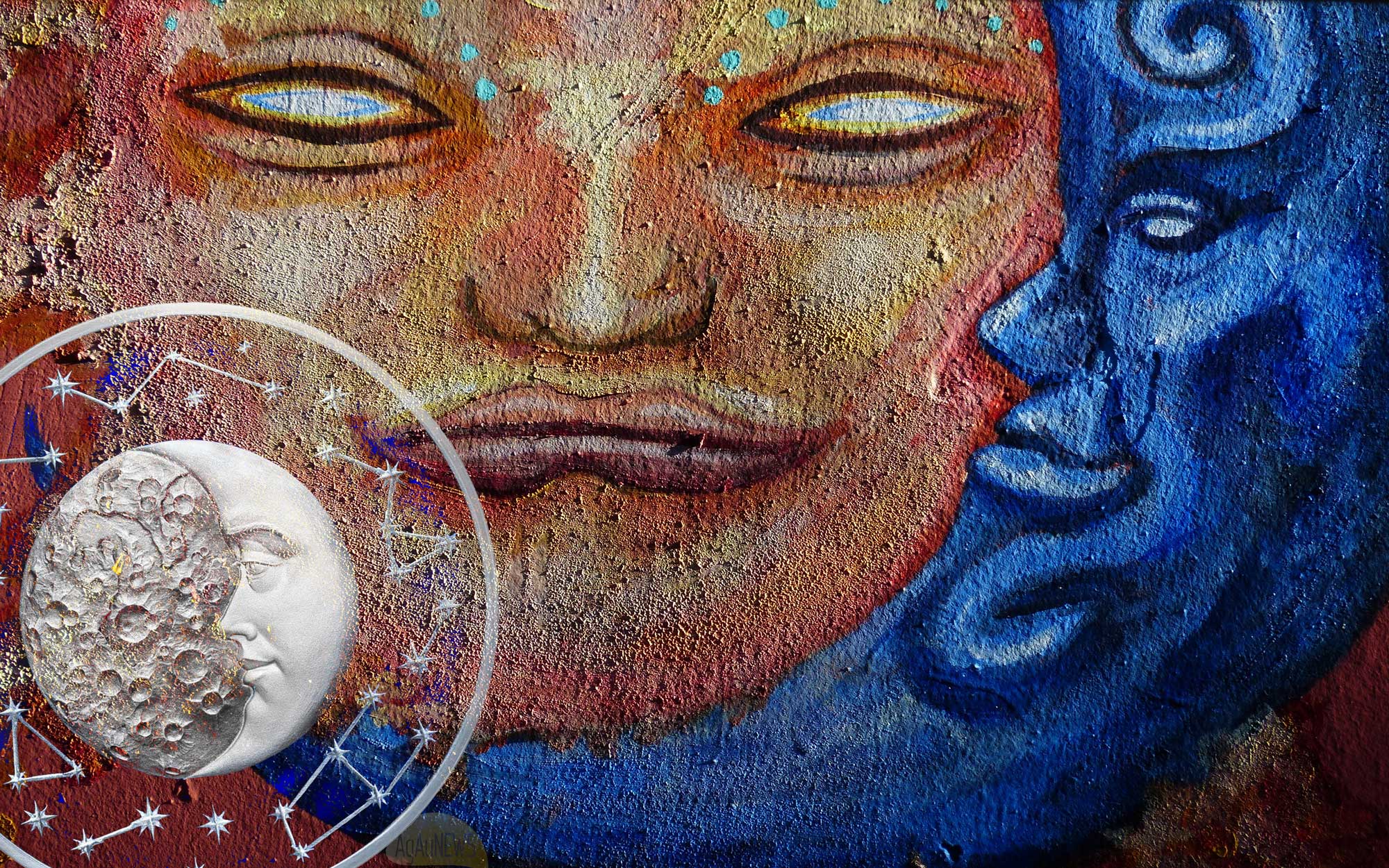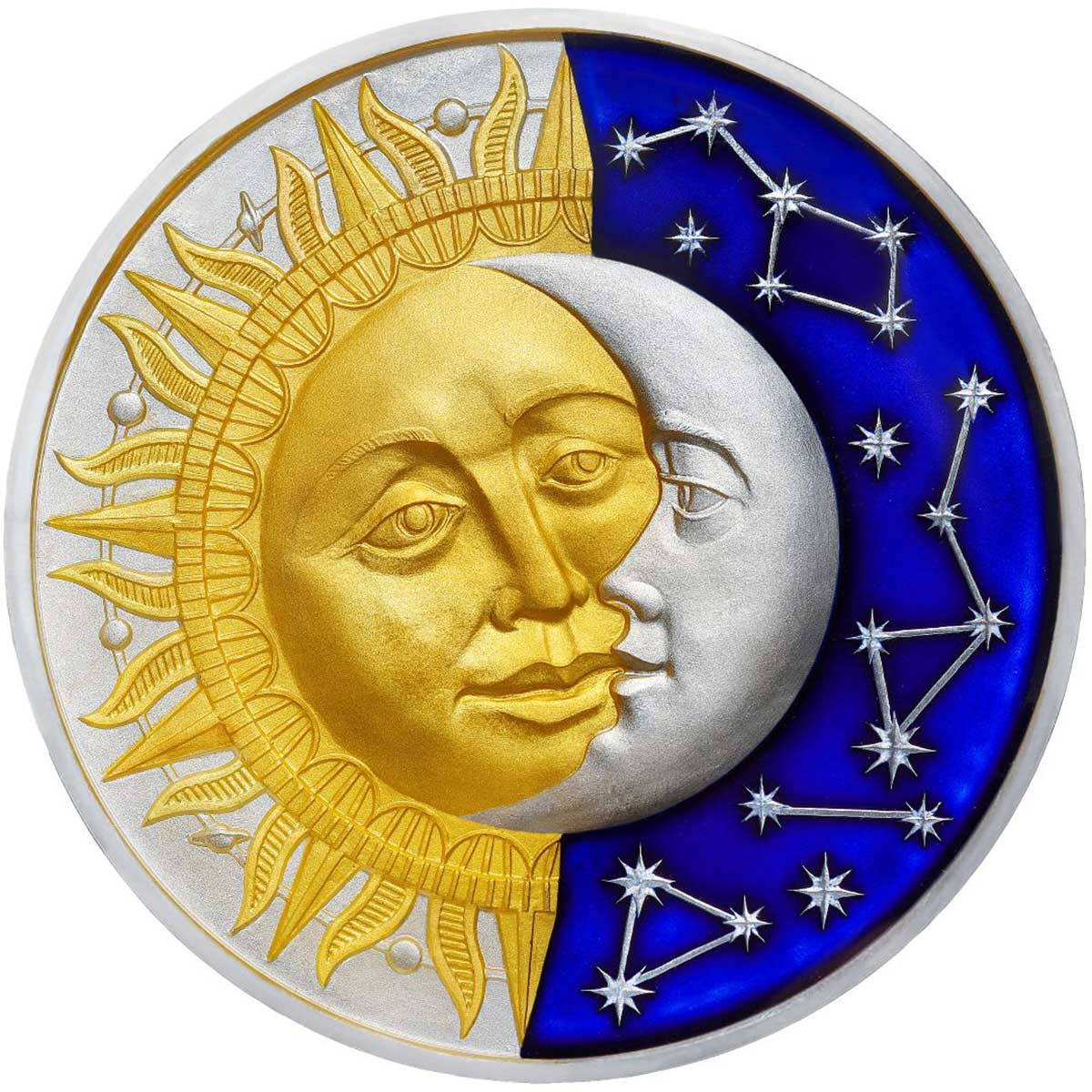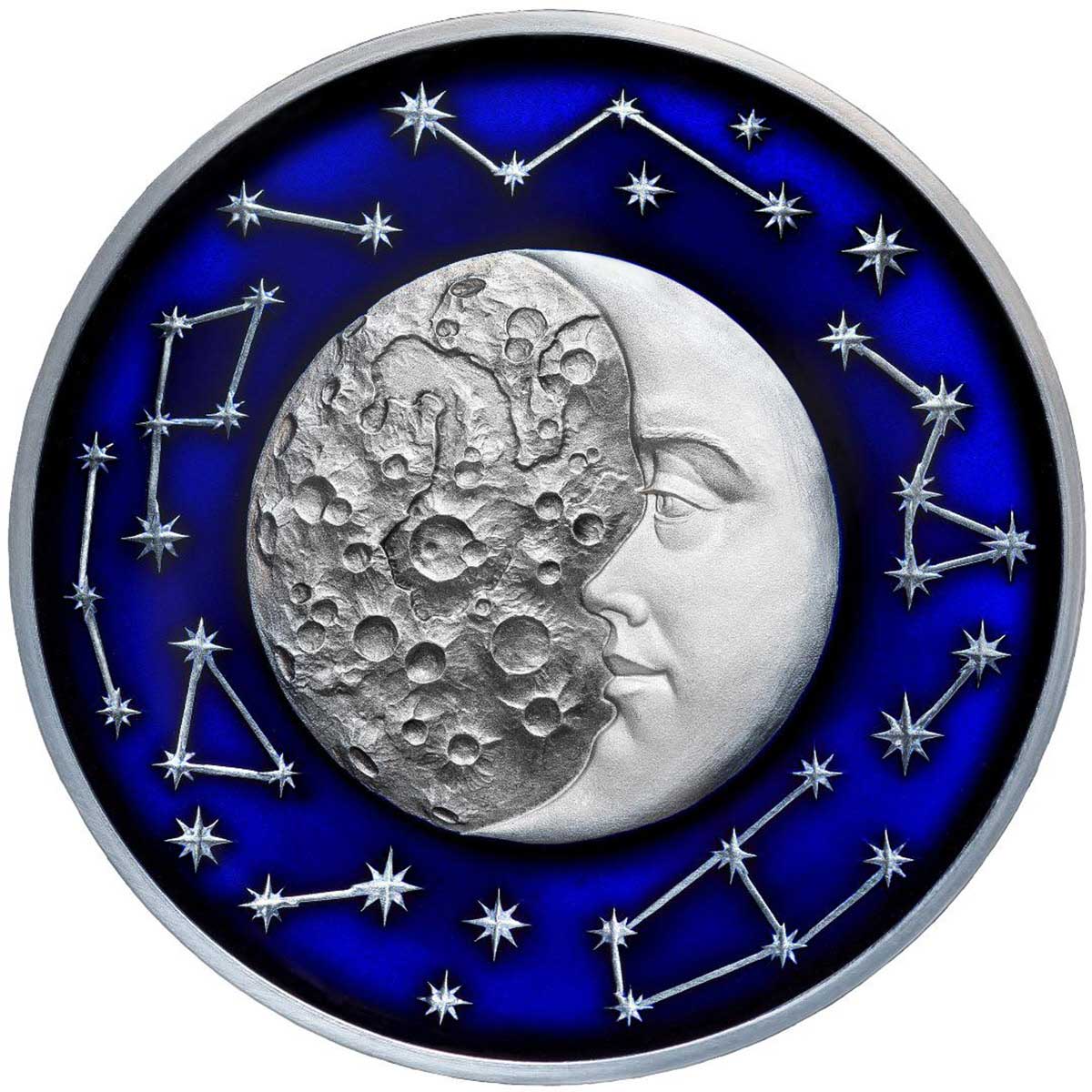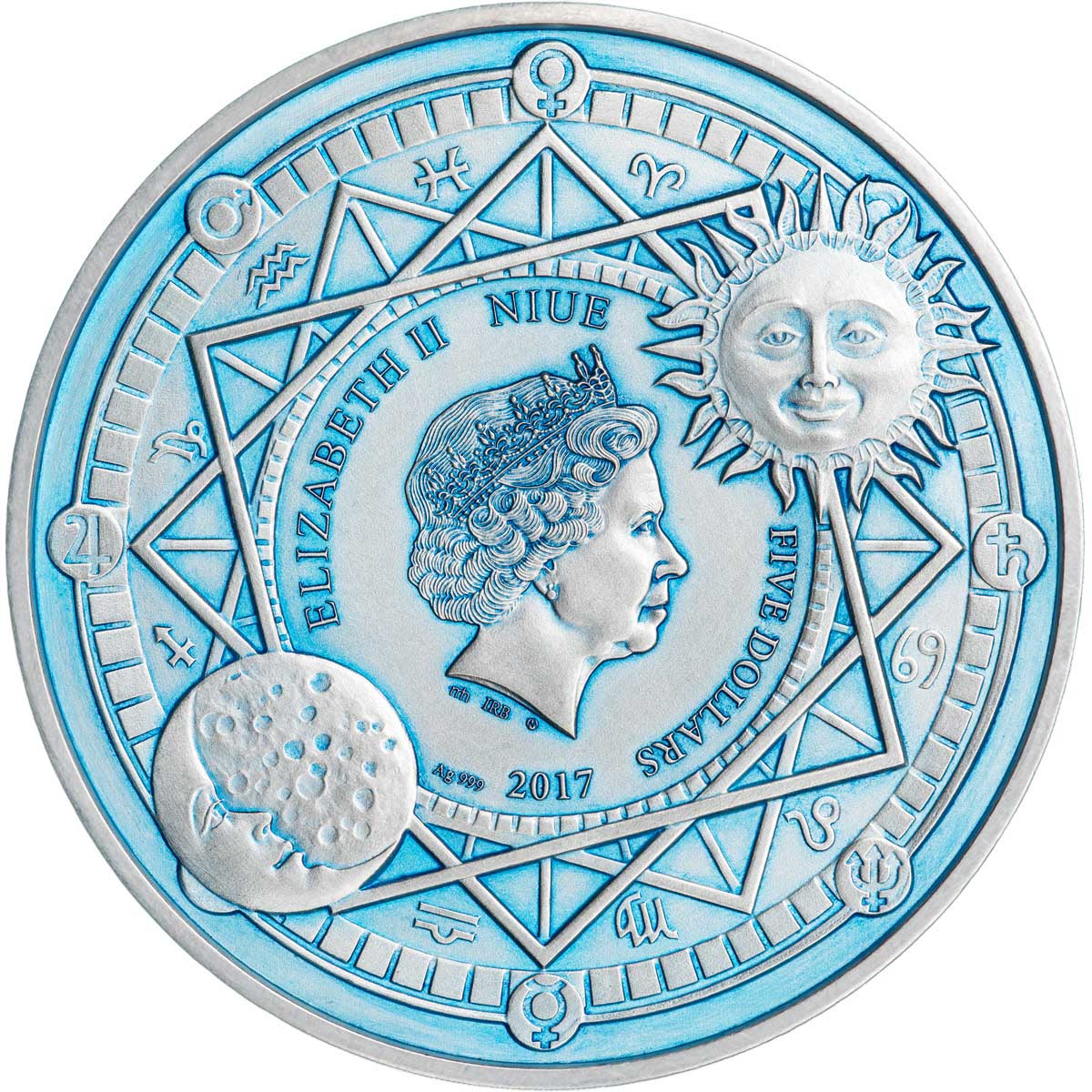Parisian producer Art Mint debuts its beautiful Celestial Bodies range of silver coins
We first saw images of this new series from Art Mint way back in Berlin in February. The three coin part gilded series was called Celestial Bodies and featured stylised representations of the sun and the moon. Fast forward to today and the series has arrived in a newly enhance format and with some new techniques in tow.
Each coin is struck in two-ounces of fine silver, one depicting the sun, one of the moon, and one an amalgamation of the two. All are from the pen of talented designer, Miroslav Hric, the man responsible for the Chinese Mandala coin, also from Art Mint. The coins are antique-finished, but the obverse employs a unique blue-patina finish. Usually black with regular antiquing, this process was co-developed by Art Mint and is apparently adaptable to other shades. We’re almost certain to see different coloured patinas on future releases. The obverse design is a cool mix of astrological symbols and miniatures of the reverse face images of the sun and moon. Issued for Niue, the obligatory Queens effigy is present, along with all of the inscriptions denoting the coin details.
The three issues all have different reverse face finishes, though each is struck to a high-relief. The brightly gilded Sun coin has a light blue enamel application framing it. The moon coin is likewise framed in dark blue enamel and the sun/moon coin is partly enameled and partly gilded in ways that match the individual coins. All are mercifully free of any inscriptions. They’re finished with a hard-glazed finish that covers and protects the entire reverse face.
The designs on these are quite beautifully done. At €300 per coin, these are clearly not low-end issues, but each individual piece requires around three hours of hand finishing and goes through multiple processes until the final article is ready for sale. A mintage of just 500 pieces per coin keeps them fairly exclusive and they’re all rapidly selling out at the mint (the first coin, Sun, has already gone). Rimless, with the serial number engraved into the edge, the whole package reeks of quality – just as you’d expect from the Art Mint. The good news is that there are three new coins planned for next year and we’ll hopefully have some preliminary views of them when we hit the World Money fair in Berlin early in 2018. Available now.
The Sun is the star at the center of the Solar System. It is a nearly perfect sphere of hot plasma, with internal convective motion that generates a magnetic field via a dynamo process. It is by far the most important source of energy for life on Earth. Its diameter is about 109 times that of Earth, and its mass is about 330,000 times that of Earth, accounting for about 99.86% of the total mass of the Solar System. About three quarters of the Sun’s mass consists of hydrogen (~73%); the rest is mostly helium (~25%), with much smaller quantities of heavier elements, including oxygen, carbon, neon, and iron.
In Greek mythology, the Sun was represented by the Titans Hyperion and Helios (Roman Sol, and later by Apollo, the god of light). The Sun is the star at the center of our solar system, around which the Earth and other planets revolve and provides us with heat and light. The arc that the Sun travels in every year, rising and setting in a slightly different place each day, is therefore in reality a reflection of the Earth’s own orbit around the Sun. This arc is larger the farther north or south from the equator latitude, giving a more extreme difference between day and night and between seasons during the year. The Sun travels through the twelve signs of the zodiac on its annual journey, spending about a month in each.
The Sun is the ruling planet of Leo and is exalted in Aries. Astrologically speaking, the Sun is usually thought to represent the conscious ego, the self and its expression, personal power, pride and authority, leadership qualities and the principles of creativity, spontaneity, health and vitality, the sum of which is named the “life force”. One of the first recorded references to Sun worship is from the Mesopotamian Religion and described in the Epic of Gilgamesh. The 1st-century poet Marcus Manilius in his epic, 8000-verse poem, Astronomica, described the Sun, or Sol, as benign and favorable. In medicine, the Sun is associated with the heart, circulatory system, and the thymus. In Ayurveda, it rules over life-force (praan-shakti), governs bile temperament (pitta), stomach, bones and eyes. In modern astrology, the Sun is the primary native ruler of the fifth house.
The Sun is associated with Sunday. Dante Alighieri associated the Sun with the liberal art of music. In Chinese astrology, the Sun represents Yang, the active, assertive masculine life principle. The enormous effect of the Sun on Earth has been recognized since prehistoric times, and the Sun has been regarded by some cultures as a deity. The synodic rotation of Earth and its orbit around the Sun are the basis of the solar calendar, which is the predominant calendar in use today.
The Moon is an astronomical body that orbits planet Earth, being Earth’s only permanent natural satellite. It is the fifth-largest natural satellite in the Solar System, and the largest among planetary satellites relative to the size of the planet that it orbits (its primary). Following Jupiter’s satellite Io, the Moon is second-densest satellite among those whose densities are known. The Moon is thought to have formed about 4.51 billion years ago, not long after Earth. There are several hypotheses for its origin; the most widely accepted explanation is that the Moon formed from the debris left over after a giant impact between Earth and a Mars-sized body called Theia.
The Moon is in synchronous rotation with Earth, always showing the same face, with its near side marked by dark volcanic maria that fill the spaces between the bright ancient crustal highlands and the prominent impact craters. It is the second-brightest regularly visible celestial object in Earth’s sky, after the Sun, as measured by illuminance on Earth’s surface. Its surface is actually dark, although compared to the night sky it appears very bright, with a reflectance just slightly higher than that of worn asphalt. Its prominence in the sky and its regular cycle of phases have made the Moon an important cultural influence since ancient times on language, calendars, art, mythology, and, it is often speculated, the menstrual cycles of the female of the human species.
In Roman mythology, the Moon was Luna, at times identified with Diana. Astrologically speaking, the Moon is associated with a person’s emotional make-up, unconscious habits, rhythms, memories, moods and their ability to react and adapt to those around them. It is also associated with the mother, maternal instincts or the urge to nurture, the home, the need for security and the past, especially early experiences and childhood. The 1st-century poet Manilius described the Moon, or Luna, as melancholic.
The Moon or Luna is associated with Monday, the word Monday comes from the Old English word for Moon day or Moon’s day, and in Romance languages, the name for Monday comes from luna. Dante Alighieri associated the Moon with the liberal art of grammar. In Chinese astrology, the Moon represents Yin, the passive and receptive feminine life principle. In Indian astrology, the Moon is called Chandra or Soma and represents the mind, queenship and mother. The Moon has been the subject of many works of art and literature and the inspiration for countless others. It is a motif in the visual arts, the performing arts, poetry, prose and music.
SPECIFICATION
| NAME | 2017 CELESTIAL BODIES |
| DENOMINATION | $5 New Zealand |
| COMPOSITION | 0.999 gold |
| WEIGHT | 62.2 g |
| DIAMETER | 50.00 mm |
| FINISH | Antique |
| MODIFICATIONS | Selective enamel and/or gilding |
| MINTAGE | 500 each |
| BOX / COA | Yes / Yes |










Leave A Comment